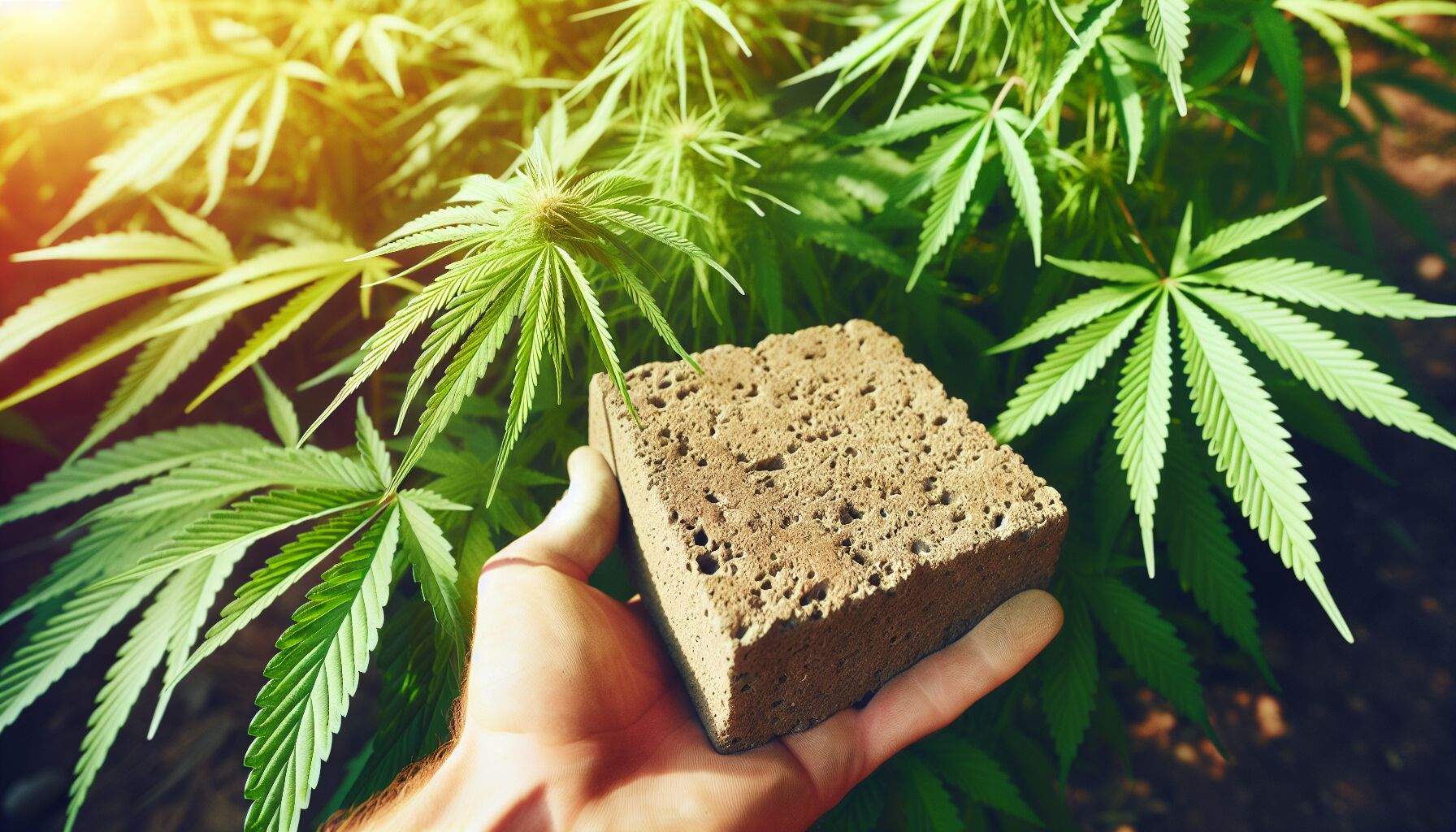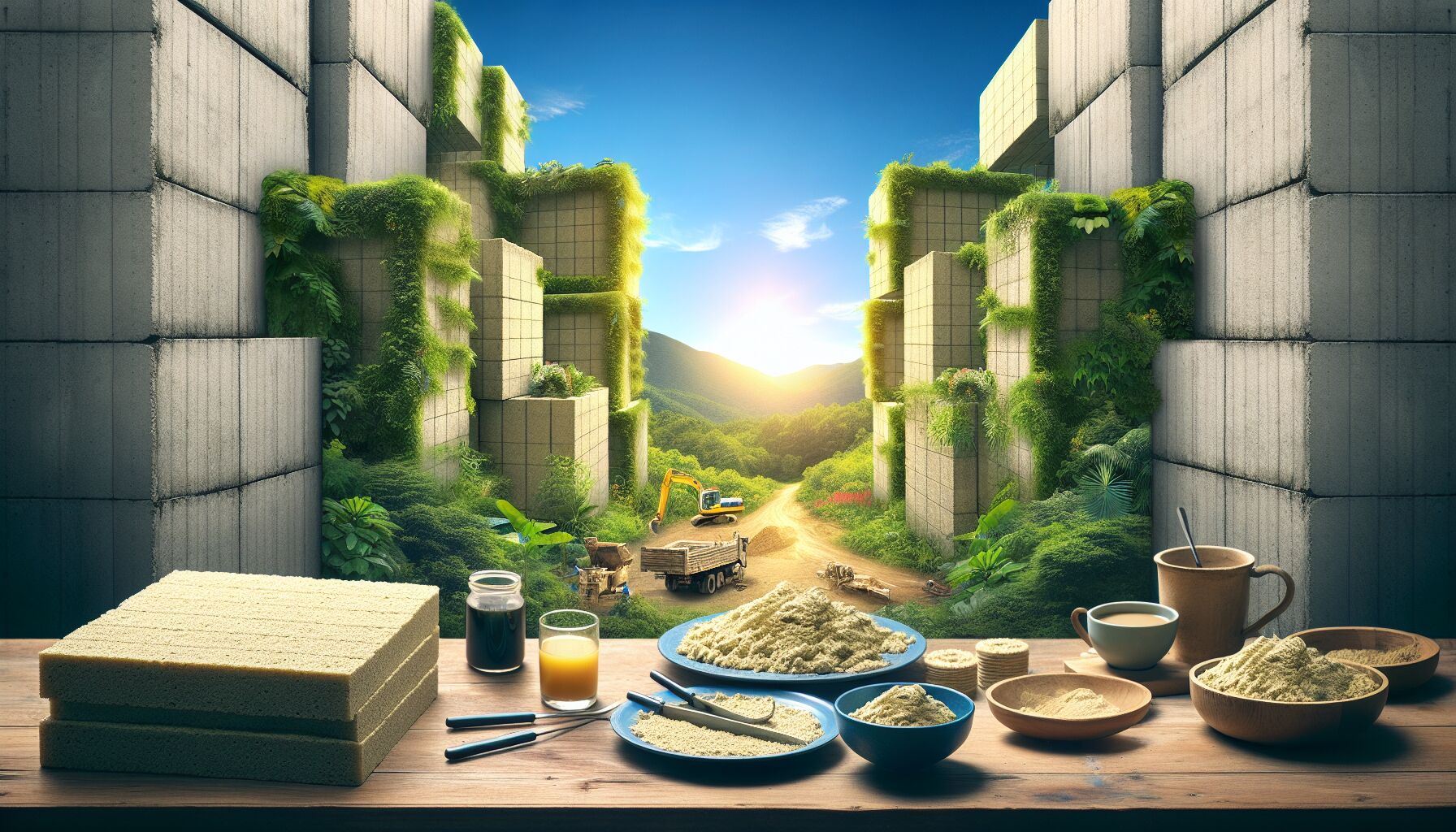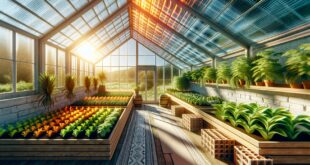 Imagine the whisper of a breeze gently rustling through the fields. You stand amidst rows of tall, green hemp plants, each one a testament to nature’s resilience and ingenuity. This is where the magic of hempcrete begins — a natural building material transforming the way we think about constructing homes, blending the old with the new and the natural with the practical.
Imagine the whisper of a breeze gently rustling through the fields. You stand amidst rows of tall, green hemp plants, each one a testament to nature’s resilience and ingenuity. This is where the magic of hempcrete begins — a natural building material transforming the way we think about constructing homes, blending the old with the new and the natural with the practical.
Hempcrete stands out not just for its environmental benefits but for its very nature, literally. Made from the woody core of the hemp plant, combined with lime and water, it creates a robust yet lightweight material that feels like it’s breathing with the Earth. What’s striking about hempcrete is its ability to naturally regulate humidity. Think about it — a material that helps maintain a healthy moisture balance in your living space, much like a gardener tending to their lush garden, ensuring every plant gets just the right amount of nuture. This breathability reduces the chances of mold and dampness, adding layers of health benefits to the cozy warmth of eco-homes.
Traditional insulation wants to keep the heat in or out, but hempcrete seems to understand the symphony of seasons. It offers thermal mass, absorbing heat slowly and releasing it just as gradually, helping homes stay warm in the winter and cool in the summer. This characteristic can contribute to significant energy savings, reducing reliance on artificial heating and cooling systems — a step closer to self-sufficiency and mindful living.
Now, let’s talk carbon footprint. The construction industry is notorious for its carbon emissions, and rightly so, but hempcrete comes with a green promise. The hemp plant itself, within its growth cycle, absorbs more carbon dioxide than is emitted in the production of hempcrete. You could say it’s Mother Nature’s way of balancing the scales, offering a building material that actively contributes to reducing the overall carbon footprint. In other words, each hempcrete home acts like a silent warrior, helping to heal our planet’s wounds.
Another fascinating aspect? Hempcrete builds with patience, requiring a different mindset from speed-focused construction methods. But like a slow-cooked meal that tantalizes the senses with its rich aromas, the result is a home that harmonizes with its surroundings — sturdy, dependable, and sustainable. You start seeing your home not just as a shelter but as a part of a larger ecosystem, a footprint that doesn’t trample, but treads lightly.
Of course, one can’t ignore the simplicity and safety of working with hempcrete. It’s non-toxic and easy on the hands, an ally for the worker’s safety, reminiscent of the ancient craftsman working with clay, wood, and stone. This all brings us back to the heart of what’s truly beneficial about hempcrete in construction: it’s not just about creating walls; it’s about building with intention, and dare I say it, with love.
It is said best by environmentalist John Muir: “In every walk with nature one receives far more than he seeks.” Utilizing hempcrete in construction could very well be part of this walk, a journey that leads us back to nature’s nurturing embrace, infusing our homes with the serene rhythm of the natural world. Wouldn’t you agree that’s something worth building upon?
Comparative analysis with traditional building materials
In the bustling chorus of construction chatter, traditional building materials like concrete, brick, and steel have held their own for eons. They’ve built our skyscrapers and lined our streets — sturdy, indeed. But here’s where things get fascinating: when you place hempcrete alongside its aged cousins, a different tale unfolds, one rooted in sustainability and simplicity.
Traditional concrete brings strength, no doubt, but with significant environmental baggage. The Environmental Protection Agency (EPA) notes that concrete production is a notable contributor to global CO2 emissions. It’s like running a marathon with weights on your feet; efficient in theory, but exhausting to our planet. Meanwhile, hempcrete, that humble mix of hemp hurds, lime, and water, sits lightly on Earth’s shoulders. It manages to craft buildings that not only stand firm but breathe life back into the environment, absorbing CO2 over their lifecycle. Don’t you think that’s a step worth taking?
Let’s consider thermal performance. Traditional materials like brick and concrete act like stoic guards against the elements, creating walls that neither yield nor adapt. But hempcrete? It dances with the seasons. Its ability to slow thermal transfer means homes built with hempcrete remain a cozy refuge against harsh winters and gentle coolness during summer heights, all without high energy demands. Imagine cutting down your energy bills while remaining snug as a bug in a rug — that’s hempcrete’s promise.
Diving deeper, think about moisture. Traditional options often play it stiff, blocking out the slightest hint of humidity. This can lead to trapped moisture and the consequent formation of mold. Now, that’s not the kind of houseguest you want lingering around. On the flip side, hempcrete welcomes moisture when it needs to, helping to maintain a healthy indoor climate by naturally regulating humidity, much like a seasoned gardener nurturing plants to bloom just right.
But there’s more. Traditional materials demand maintenance and repair, holding you at their whim with time-consuming patches and fixes. Hempcrete, though, whispers a simpler tune. It’s robust yet delightfully low-maintenance, offering longevity without the headaches of frequent touch-ups. It’s as though your home is a well-versed musician, playing a timeless tune that requires little tuning.
In contemporary construction, the cost is king. Traditional materials often win this round simply by existing in established supply chains. Hempcrete, however, proposes a different kind of value. The upfront costs might be steep, but here’s the clincher: the return on investment is profound in terms of energy savings and environmental restoration. As with any wise financial decision, it’s about long-term gains over short-term benefits.
The slow embrace of hempcrete might remind one of embracing an old friend — something familiar yet newly appreciated in its potential. It offers an invitation to share space with nature and invest in a future where eco-homes don’t seem like an extravagant ideal but a given reality.
In this quiet revolution, future-ready builders and mindful homeowners unite, crafting homes that feel more organic than engineered. If the old ways embrace endurance, hempcrete embodies vision — gently carving a path toward buildings that honor the Earth beneath them. Isn’t it time we listened to that soft and inviting call to think anew? As with any great journey, the difference lies in not just where we build but how and, more importantly, why.
Challenges and future prospects of hempcrete innovation
 Hempcrete, a standout in the realm of natural building materials, is forging a fresh path but not without its share of challenges. Isn’t it curious how every material, much like every person, carries its own set of hurdles and promises?
Hempcrete, a standout in the realm of natural building materials, is forging a fresh path but not without its share of challenges. Isn’t it curious how every material, much like every person, carries its own set of hurdles and promises?
First up is the regulatory landscape. Hemp, despite its myriad uses, has long been tangled in legal webs due to its connection to cannabis. This complex relationship cultivates a need for ongoing advocacy and education to separate industrial hemp from its controversial cousin. Such efforts can transform hempcrete from a niche material into a standard bearer for sustainable building.
The supply chain presents another conundrum. While hemp is one of the fastest-growing plants, accessing consistent, high-quality hemp hurd can be a game of patience. This issue often translates into higher costs and limits the speed at which hempcrete can be adopted. Yet, as more farms dedicate acreage to hemp cultivation — supported by changing legislation — this bottleneck might soon become part of our shared past. Check out resources like the U.S. Department of Agriculture (USDA) for insights on hemp agriculture’s burgeoning journey.
Now, consider the weight of tradition. Builders are creatures of habit, and shifting away from materials like conventional concrete involves both learning and risk. Education and training are critical to easing this transition, helping us all imagine a future where eco-homes are less of an alternative narrative and more the main story. Organizations like Hemp Industry Daily offer glimpses into how industry leaders are guiding these educational efforts, ushering us quietly yet persistently toward change.
Surprisingly enough, hempcrete’s own properties pose a challenge in climates with high humidity or persistent rain. Its ability to wick moisture is a double-edged sword, demanding that builders employ careful planning and design. Protective measures, like rainscreens and adequate roofing, can mitigate these moisture-related risks, ensuring homes built with hempcrete remain sanctuaries that harmonize with, rather than succumb to, their environments.
Looking to the future, the prospects for hempcrete are encouraging. As the world becomes more eco-conscious, the demand for materials that heal rather than harm grows. Innovators are exploring hybrid blends, integrating hempcrete with other sustainable materials to push boundaries and enhance resilience. As these experimental phases give way to tangible solutions, hempcrete’s place in construction could solidify, like the foundations it helps support.
Isn’t it something to remember how the old must give way to the new, inviting progress like an old friend? That same sensibility holds true for hempcrete’s journey, intertwining the past and future with the delicate threads of intention and integrity. It’s as if in building homes from hempcrete, we’re also laying the cornerstone for a more connected existence — one where our living spaces reflect deeper values and show a reverence for the Earth.
In the words of architect and visionary Frank Lloyd Wright, “Study nature, love nature, stay close to nature. It will never fail you.” Maybe, just maybe, hempcrete is one of the bridges that allow us to build closer to the natural world, nudging us to listen, learn, and lead with heart.
 DS Haven In Light Of Things
DS Haven In Light Of Things






